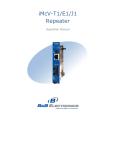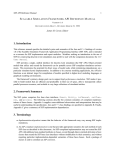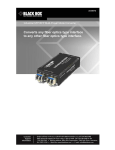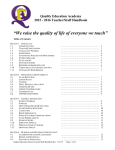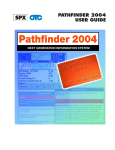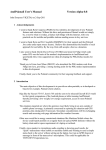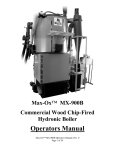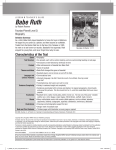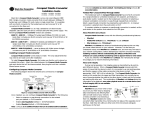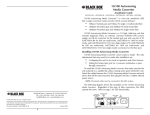Download End Wrench 02.05 - SubaruForester.org
Transcript
Time > T-Belt All About OHC Timing Belts Pushrod-actuated valves may have been simple, but there was no way they could ever offer the kind of performance available from SOHC and DOHC designs. Subaru went OHC two decades ago. 4 | The End Wrench > w w w. e n d w r e n c h . c o m ay back in the mid-’60s when we first heard of the idea of driving a camshaft with a rubber belt, we thought the idea was radical, maybe even implausible. It takes quite a bit of force to turn a cam, after all, and isn’t perfect synchronization absolutely critical? How could a belt possibly hope to achieve the precision necessary? Since time immemorial, engineers had used gears or chains and sprockets, which were relatively rigid and accurate. Why mess with that and introduce such an incredible departure from tradition? Well, there were lots of good reasons, which we traditionalists were just going to have to accept. First, those belts aren’t plain rubber.They’re reinforced with tough fiberglass strands that don’t stretch, and their synchronous teeth are very accurately made. Next, it’s always been an engineering challenge to keep the long chains or gear trains necessary for overhead cam engines quiet and trouble-free. Also, if there was a failure of a chain, a sprocket or a gear, the oil tightness of the engine would have to be violated to perform the repair, and that meant there was always the potential of comebacks for lube leaks. A timing belt is inherently quiet, and its replacement is an external job. W Snap! Against those positive points, however, must be weighed a major negative:A belt may break unexpectedly at any given moment, which will stop a car as thoroughly as a thrown rod would (not a common occurrence with the tough Subaru bottom end). With interference-type engines, which have nasty collisions between pistons and valves, or perhaps between intake and exhaust valves on DOHC designs, this can mean a serious financial setback. Also, as one independent repair shop owner puts it, “Even if it’s a non-interference engine, you’re still gonna be walking.” Subaru went from OHV to OHC in 1985, and the change allowed for vastly improved engine performance. Generally, durability and dependability were good, but not perfect. That 1.8L boxer, which remained in the Loyale through ‘94 (the newer Impreza 1.8L is based on the singlebelt Legacy 2.2L), had two somewhat troublesome timing belts. Techs used to say that they didn’t make it to the recommended replacement interval (60,000 miles), and that you could tell the belt was ready to go when you heard a knock at the distributor. As a former Subaru trainer tells The End Wrench, “With the old-style timing belts, the first symptom was distributor knock. What you’re hearing is gear backlash, which sounds more destructive than it really is. Pushing on the distributor housing will isolate the source of the knock.” The newer design engines use a hydraulically-actuated automatic adjuster and a single belt with curvilinear teeth, which make for much longer belt life (the shape creates less friction and therefore runs cooler). In fact, since 1996 Subaru has said you can go 105,000 miles before replacing the belt on a 2.5L (the 2.2L Legacy motor offered through ‘98, however, has an interval of 60,000). Here’s the original 2.2L Legacy single-belt set-up. Note that the arrows on the cam sprockets are for piston position, not valve timing. Spring 2005 • Number 29 | 5 This is what the 2.2L hydraulic tensioner looks like inside. 8 | The End Wrench > w w w. e n d w r e n c h . c o m Simply stated, Subaru vehicles have fewer OHC timing belt problems than other cars, just as they give less trouble in general.The O.E. belts themselves are of the highest quality, and the sprockets are finely made and run true. The hydraulic tensioner mechanism keeps just the right amount of pressure on the backside of the belt. But this is no excuse for exceeding the interval. Subaru adopted the curvilinear belt configuration long ago because it builds up less heat than the trapezoidal-type does. Getting The Job useful life. That means you’re seeing many high-mileage specimens at your door, a large percentage of which are owned by people who’ve never looked at the maintenance recommendations and are often way beyond the replacement interval — a breakdown just waiting to happen. Failure Factors But there’s more to belt-change intervals than just mileage. Heat is the main killer of rubber products in general and timing belts in particular. So, if you live in a hot climate you can figure that you’ve got to do belt replacements before the recommended mileage is reached, certainly not after. That doesn’t mean that those of you who live in relatively cold places can let your customers slide, however.There’s summer most everywhere cars are in use, after all. So, the recommended replacement interval isn’t necessarily a figure cast in stone. Use common sense on a case-by-case basis when it comes to timing belts. If the car is being operated at high speed in hot areas, time may be just as important a factor as mileage.While nobody likes being accused of overselling, that customer who’s left stranded somewhere would be a much greater blotch on your reputation. Oil and antifreeze are also very destructive to timing belt rubber. That little oil drip out of the front cover may not be bothering the owner of the car much, but you’d be doing him or her a favor by explaining how much timing belt life is shortened by such contamination. Also, this lends justification to the addition of seal replacement to the belt job. What Happened? Although these replacement recommendations are clearly stated in the owner’s manual maintenance section, for some reason this is still a frequently-overlooked service opportunity. It’s a pretty easy job to sell if you take the time to explain to your patrons the consequences of putting it off. As one shop owner says, “We highly recommend it, and one of the things we do is watch our service intervals on our computer. If it’s a 60,000 interval and he’s in here at 57,000, he’s got a printout and an estimate.” Another independent service shop owner goes even further. “No matter what the car’s in for, if it’s got a timing belt the tech writes ‘timing belt?’ on the work order, and the office checks to see if we’ve ever put one on that car,” he says. “If not and it’s getting near the recommended mileage, we have a little talk with the car’s owner.” Also, when you call this shop and you’re put on hold, a nice, professional voice tells you, “Most manufacturers recommend that you replace your overhead cam timing belt on a regular basis. Have you had yours replaced?” Although the 105,000-mile interval worries some people, the experience of the Subaru specialists we’ve talked to is that they rarely if ever fail before that. Of course, Subaru owners tend to put lots and lots of miles on their cars, so that mileage may only represent, say, a third of the vehicle’s Timing belt problems will result in a customer telling you that his car (a) suddenly refused to fire up, (b) just stopped dead, or (c) has little power or a weird idle. Here are some sensible policies to follow whenever you’re presented with one of these situations. Naturally, diagnosis comes first. In the case of a no-start, find out if the cams are turning. In some Subaru engines, you can look down into the oil filler cap and watch the cam during cranking. Otherwise, see if you can get an idea by looking through the gaps in the belt covers. If there’s no movement, you’ve uncovered the problem instantly. Another simple check you can use on older models that have plug wires is to blow the dust off your timing light, hook it up, then crank. If there’s no flash, maybe the distributor shaft isn’t turning because it’s no longer connected to the crank. If you’ve got spark, but the marks are way out or wave all over the place, you’ve found evidence of jumped time or loose sprockets. Of course, direct inspection will give you the most definitive information.The belt may be broken, frayed, or have worn or disintegrating teeth. If it’s chewed up on its inner surface, check the pulleys.A small nick or corrosion can ruin the rubber in no time.“We check all idlers and pulleys carefully and replace them if there’s any roughness at all,” says one independent. Spring 2005 • Number 29 | 9 T-Belt Time independent Subaru service specialist tells The End Wrench, “I know you’re supposed to immediately do a disassembly and inspection if a 2.5L snaps a belt. But you won’t do any damage if you remove the spark plugs, rotate the crank carefully so that all the pistons are at half-mast, then do a cylinder leak-down test. That’ll tell you if any valves are bent. Sometimes you luck out and the crankshaft stops spinning before any damage is done. That would be good news to the customer. Maybe for you, too, if you find other types of service to be more profitable than internal engine work.” Those sprockets have to be in absolutely perfect condition or the best belt in the world won’t last. Look them over carefully for nicks, corrosion, rough areas, etc., and replace them if there’s any question. Of course, never turn them with a chain wrench or anything else that could possibly gouge or scratch the teeth. Heavy Hitters Unfortunately, you can’t make an accurate estimate of the job until you find out whether or not the engine is of the interference variety. If it is, the repair may have to include pulling the heads for the installation of some new valves. Unlike most other Asian engines, Subaru 1.8L and 2.2L engines are freewheeling — no bent valves if the belt should break. We consider this good engineering practice and the mark of a company that really believes in giving its customers solid, long-lasting products. Of course, even though there won’t be catastrophic internal engine damage, the car will stop dead, perhaps stranding a family in an awkward situation, so replacement at the proper interval is still very important. Meanwhile, it was impossible to accomplish the freewheeling feature given the crowded combustion chamber of the 2.5L boxer and still achieve maximum performance and efficiency. So that motor is indeed “a hitter,” as we technicians put it. But there’s more to the story. On the 16-valve DOHC version, if the cams are out of synch there’s a good chance the intake and exhaust valves will collide with each other, perhaps bending them. So, turn those sprockets with as little force as possible, and if you feel anything touch, go back the other way. Which brings us to an interesting question: Just because it’s supposed to be a hitter, did it actually hit? And, if so, did this collision do any valve damage? As one exceptional 10 | The End Wrench > An old-fashioned cylinder leak-down test can help you find out if that snapped or slipped belt has caused valve damage. Remove all the plugs, rotate the crankshaft very gently until all the pistons are at half-mast, lock it there, turn the cams until the valves are closed, and introduce compressed air through this gauge into each spark plug hole in turn. Another logical alternative is to hang a belt and do a traditional compression test. “The first thing we tell the customer is that we need to put on a new belt, then do a compression test,” an award-winning independent says. “You don’t have to reassemble it completely, but just put it back together enough to crank it. We’ve found that chances are pretty good that there’s no damage.” Another shop owner corroborates, saying, “Hang a belt and do a compression test.We always explain up front that this is an estimate. If the compression test shows a problem, we stop there and call the customer with our suggestions.” One authority reports that about 25% of interference engines will survive belt failure without serious damage, but he adds as a warning that it takes very little drop off in engine vacuum (due to slightly bent valves) and the consequent MAP sensor voltage increase to trigger an emissions failure due to an overly rich condition. In Synch Neck-snapping performance? You’re just not going to get it if you’re even one tooth out. So, whenever you’ve got what appears to be a valve timing problem, look up w w w. e n d w r e n c h . c o m the alignment marks (see sidebar). Remember that a onetooth mistake will commonly put timing off by about 15 degrees. We don’t know what your experience has been, but we’ve seen and heard about numerous out-of-synch cases due to faulty assembly, some of which not only resulted in poor performance, but also set DTCs (Diagnostic Trouble Codes). One shop owner gives us an example: “We’ve fixed lots of cars that didn’t run right after they’d had a new belt installed,” he says. “We just did one the other day that had been to two other shops with a complaint of poor power. It had a code in the computer for the crankshaft position sensor, but the sensor was sending out a perfect signal. The idea just came to me that the timing might be off.When we pulled the cover there was a brand new belt, but it was one tooth out.We put it on right and it ran great and the code never came back.” Identifix often gets calls from techs stumped on a nostart with supposedly all the magic ingredients: Spark, fuel, and compression at 110 psi.The problem is a skipped belt. A properly timed car will typically crank out 175 psi. Two teeth off will drop it to around 110 and the engine won’t start.You might want to think about checking ignition timing while cranking the engine. Also, faulty valve timing is a common cause of emissions test failures for excessive CO. Water Pump? Concern for your patrons and simple logic both dictate that you think about installing a new water pump whenever you’re replacing a timing belt on a Subaru. As one specialist who “eats, sleeps and breathes Subaru” puts it, “We try to encourage customers to replace the water pump when we do a timing belt because it represents a real savings in labor costs. And the O.E. pump only costs $85 to $92.” Another shop owner adds, “In all cases where the water pump is driven by the timing belt we recommend that the pump be replaced at the same time, but we let the customer make the decision.” Wary of being accused of over-selling, an award-winning independent takes a slightly different tack. “Our policy is that we tell the customer that we’re not saying the water pump is bad, but that we’ll examine it carefully,” he says. “We’ll look at the weep hole and feel roughness or play in the bearing. We don’t want them to think we just want to put parts on. With interference-type engines, we’re really critical about pumps because if the bearing gets wobbly or seizes, valves will be bent.” Our opinion? Well, you could skip the new pump on a 60,000-mile interval engine without being accused of dereliction of duty, but most water pumps are getting pretty Spring 2005 • Number 29 | 11 T-Belt Time near the end of their useful life by 105,000, so we definitely believe replacement is justified — it’s a valuable service for the customer that’ll save him or her money in the long run. It’ll also add profit for you. ■ Never bend a belt to a radius of less than 2.5 in. ■ Timing belt service is no place to economize with discount parts. As one specialist says, “We use nothing but O.E. belts. If I ever have to send the car back to the dealer for any reason, I want to be comfortable with what I’ve installed.” ■ A high-performance, low-stretch T-belt is available from SOA that cuts valve timing error from 1% (that can be over three degrees) to .07%. That’s more accurate than even a chain would be, so it should be popular with tuners who are trying to wring every last horse out of their engines. It carries a 70,000-mile replacement recommendation. ■ Random Notes We’ll conclude with some miscellaneous information that you won’t find in any service manual: ■ A big thing to watch out for is damaging the tensioner assembly when you compress its rod for installation, a potential problem you avoid completely when you buy a new tensioner to go with the fresh belt. It’ll come retracted, so all you have to do is bolt it on, thread the belt and pull the pin. ■ Always tighten the sprocket bolts to specifications. If they loosen up it can cause hogged-out key-ways, hard-todiagnose drivability problems, and sometimes DTCs. ■ The screws that hold the 2.2L oil pump together tend to come loose, which can direct pressure through the front seal, thus saturating the belt. There’s no need to replace the pump. Just reinstall the screws with high-strength thread locker. 12 | The End Wrench > w w w. e n d w r e n c h . c o m Foolproof: Step-by-Step R&R f you follow the instructions below to the letter when removing and reinstalling a late-model Subaru SOHC timing belt, there’s little chance of a mistake — or a comeback (of course, if you’ve got it off, you might as well install a new one, which makes painting marks on the old belt superfluous). Just do it: I 1. Remove the radiator and air conditioner fans. 2. Remove the accessory belt cover, then the belt or belts. 3. Remove the accessory belt pulley from the crankshaft nose. Use special tool ST 499977100 to lock the crank in place. 4. Remove the left and right belt covers. Spring 2005 • Number 29 | 13 T-Belt Time 5. On manual transmission models, remove the the two bolts that retain the timing belt guide above the crankshaft belt sprocket, then remove the guide. 6. If the alignment mark and/or the arrow indicating the proper direction have faded away, paint on new marks before disassembly as follows: a. Using a special crankshaft socket (ST 499987500 or equivalent), turn the crank until the mark on its sprocket is aligned with the notch in the engine block, the mark on the passenger’s side cam sprocket (c) lines up with the seam between the cylinder head and cam cap (d), and that the driver’s side cam sprocket mark (e) and the belt cover notch (f) are in alignment. b. Paint your own marks on the back of the belt corre- sponding to the teeth that match the three points of alignment. Even if you’re replacing the belt, the old one can serve as a backup reference. Of course, if the belt has snapped, forget it. 14 | The End Wrench > w w w. e n d w r e n c h . c o m Note: Here’s a great check — there should be exactly 44 teeth between the mark on the crank sprocket and the one on the passenger’s side cam pulley, and 40.5 teeth between the crank mark and the driver’s side cam mark. 7. Remove both lower t-belt idler pulleys (one has teeth), then remove the belt itself. Spring 2005 • Number 29 | 15 T-Belt Time 8. Remove the automatic belt tension adjuster assembly. a. Using a vertical press (NOT a horizontal vise) and a force of no more than 66 lbs., SLOWLY push the adjuster rod down into the assembly — take at least three minutes to allow the oil to bleed out. Go only far enough to bring the end of the pin flush with the face of the cylinder so that the stopper pin holes line up. b. Insert a 2 mm (0.08 in.) diameter pin or Allen wrench through the holes in the cylinder and adjuster rod, and release the pressure. 10. Install the tensioner and tighten its bolt to 29 ft. lbs. 9. Before installing either a new or used belt, the automatic (39 Nm). tensioner must be retracted and pinned as follows: 11. Install the driver’s side idler pulley (the one with teeth) and torque its bolt to 29 ft. lbs. (39 Nm). Note: Make sure none of the pulleys has moved from its timing mark. 16 | The End Wrench > w w w. e n d w r e n c h . c o m 12. Carefully install the belt making sure its arrow is point- ing in the right direction of rotation. Big Drag 13. Install the other idler pulley and torque its bolt to 29 ft. lbs. (39 Nm). 14. Check the timing marks again, then pull the adjuster locking pin. 15. On manual transmission models, install the timing belt guide above the crankshaft sprocket. Adjust the clearance at three places between the back of the belt and the guide to 0.039 in. (1 mm), then tighten the attaching bolts to 7 ft. lbs. (10 Nm). ne successful independent tells us about a case that can teach technicians several good lessons.The car came in with a stripped belt, so he put on a new one and tried to start it. No go. He did a compression test and all the cylinders were low, but he was smart enough not to jump to conclusions. Instead, he tried to back up his findings with a cylinder leak-down test. Lo and behold, no significant leakage anywhere.That said timing to him, but he checked again and the marks were aligned perfectly. The problem? One sprocket had sheared the Woodruff key and rotated on the camshaft. When he put a wrench on the cam and tried to turn it, he found it took a whole lot more effort than he’d normally expect. Then the story came out (which is strong evidence of the importance of careful customer communications at the outset): The car’s owner had been to a quick lube, and the oil light came on shortly thereafter as he was driving down the highway. He stopped and added oil, then the same thing happened again. Finally, it just stopped running and found its way to the repair shop on the hook. A loose oil drain plug was the culprit. Apparently, the head had been badly starved for oil and the cam seized in its bearings, but freed up somewhat after everything cooled off. ■ O 16. Install the belt covers. 17. Install the crankshaft accessory belt pulley, then the accessory belt or belts and the safety cover. 18. Install the radiator and air conditioner fans. ■ Spring 2005 • Number 29 | 17












